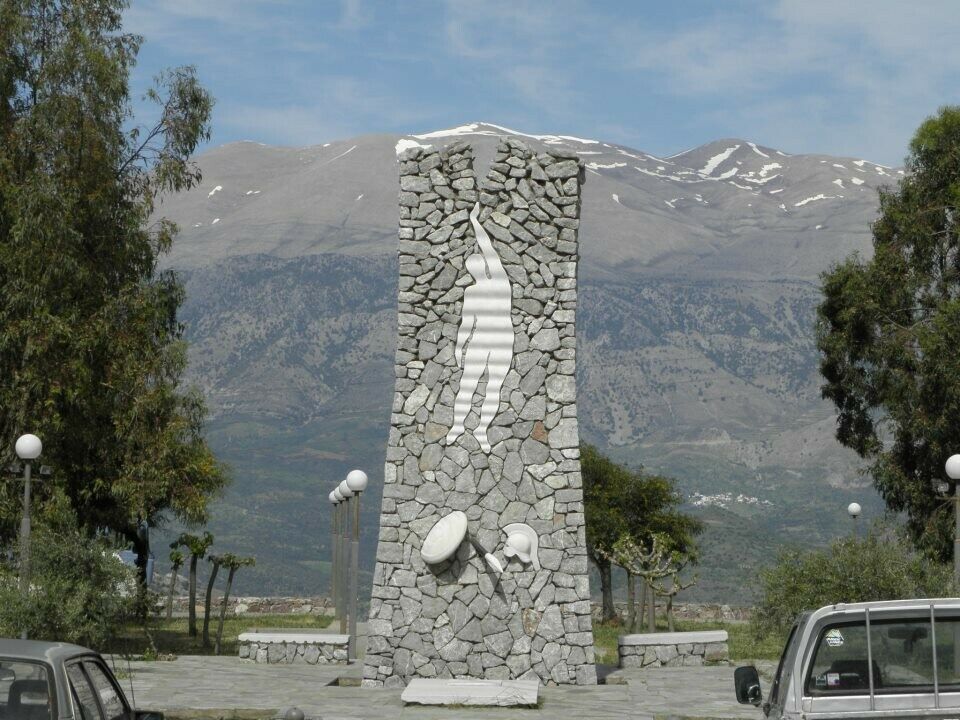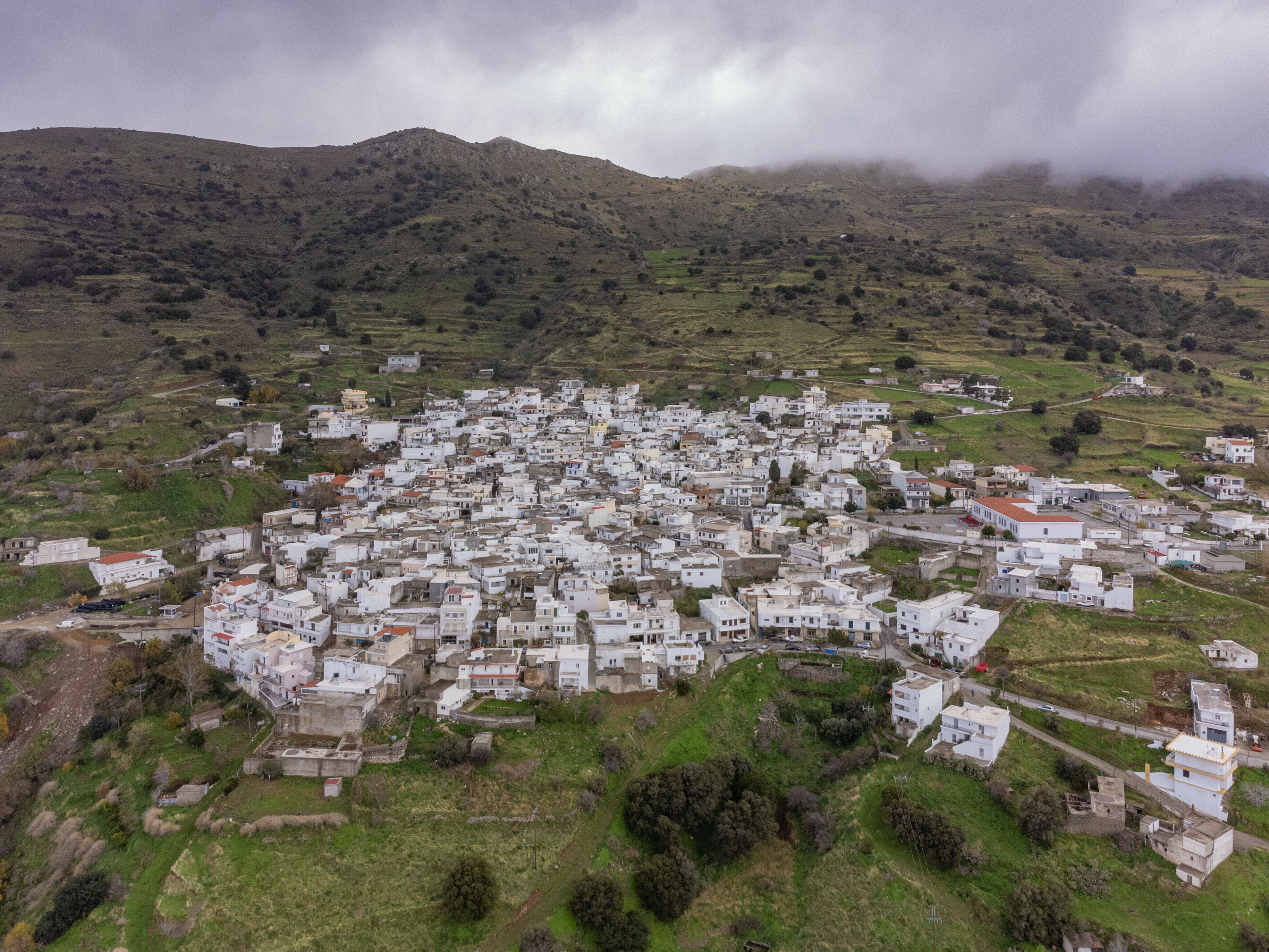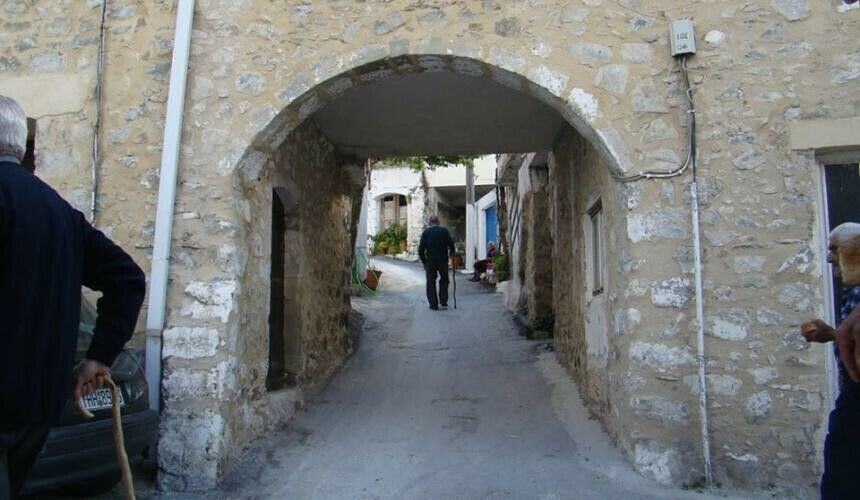"Discover the charm of Melambes, a hidden gem for both tourists and visitors."
Melambes is a mountainous village and the seat of the homonymous community in the Municipality of Agios Vasilios, in the Regional Unit of Rethymno in Crete. The name Melambes is of ancient Greek origin, characterized by a distinctive archaic nature, both typographically and phonetically inviolable. Near the village, at the location of Kouri, lies the archaeological site of the ancient city of Kori, where the ruins of an ancient temple dedicated to Elektra are located, after whom the river Elektra is named. The first historical reference to Melambes dates back to the Venetian rule in 1577 by Francesco Barozzi. In 1583, a census reported 338 inhabitants. During the Ottoman rule, the residents actively participated in all struggles, from the Greek Revolution of 1821 to the Cretan Revolution of 1866, until the last Cretan Revolution (1895-1898). In the First Balkan War, residents of Melambes, along with other villagers, formed a volunteer corps that rushed to the struggle in Epirus.
-
The village's geographical and altitudinal position, combined with its healthy, cool, and humidity-free climate, is one of the many natural advantages that offer a unique stay to visitors. Sitting in one of the cafes, one can enjoy a breathtaking view to the north, with lush perennial olive trees stretching from the village to the Platys River valley and up to Psiloritis and the Center. To the south lies the vineyard-covered slope of Vouvala. From its summit, at an altitude of 1000 m, one can see almost the entire Libyan Sea, the Paximadia islands, Gavdos, and most of the regions of Agios Vasilios and Amari, as well as the entire Messara plain. Seeking this view and the healthy environment, many tourists and hikers constantly come to the village. They often walk to Agia Galini or choose to walk among the vineyards on the rural road, reaching the summit of Vouvala to enjoy the panoramic spectacle described above.
-
The traditional architecture of the village, with its endless labyrinthine narrow alleys, simple two-story houses with balconies, and connecting chambers, along with the cleanliness easily noticed by passersby, shapes an unusual environment suitable for relaxation. In the village center, one has the opportunity to enjoy coffee or refreshments with the locals, engage in conversation, and hear about their joys and sorrows, primarily experiencing their love for their homeland.
-
The two springs within the village, with their troughs maintained for animal watering and others for washing clothes in earlier times, along with the stone-carved decoration they feature, attract passersby not only to observe but also to drink their cool water, wetting their faces or hands. From the inscriptions on their fronts, visitors learn that their landscaping works were done by the Melambes Community in August 1877 for the Upper Spring and September 1879 for the Lower Spring. In the courtyard of the Lower Spring, there is even a century-old, tall plane tree that lends its name to the entire neighborhood and constantly provides its rich shade and coolness. In this simple yet beautiful space dominated by the incessant murmur of water and the synchronized chirping of sparrows that move in the branches of the plane tree and surrounding trees, an environment is created that visitors find hard to leave. Here also is the office of the local Council, which until 1998 operated as the Community office. Additionally, the elevated democratic platform with the inscription "Wants to speak" constructed by Vangelis Psilakis during the area's redevelopment, for local and national lords to present their programs to the people and be judged.
-
The Churches both within and outside the village, spanning from the late Byzantine period to the present day, declare the rich history and deep religious sentiment of its inhabitants. Specifically, the Church of Agia Paraskevi stands out. It is a basilica-style temple from the 14th century adorned with magnificent two-layered frescoes, meticulously preserved through archaeological conservation. In combination with the giant plane tree mentioned earlier, casting its shade over it, embracing it tenderly, and the lower spring located in its northern courtyard, 5 meters lower, they create an ensemble that compels visitors to worship, light a candle in her grace, and feel a distinct sense of relaxation, both physically and spiritually. The annual celebration on July 26th is an opportunity for numerous faithful from Melambes and surrounding villages to participate.
-
The dual-aisled Church of Panagia, built in 1835, with its thick walls resembling a fortress, features an unusual bell tower and porch, showcasing an impressive architectural design after significant quality maintenance. The ancient carved iconostasis and its icons evoke a sacred reverence in the worshiper. In this monumental church, on March 25, 1867, shortly after the holocaust of Arkadi, a historic Divine Liturgy took place, attended by the soldiers from Melambes, the brave warriors of M. Korakas, Dim. Petropoulakis, and P. Koronaios, along with the villagers. At the end of the service, Arist. Spanopoulos delivered a patriotic speech about the future of the Cretan revolution. Today, most religious services take place here, including Christmas, Holy Week, and the Assumption, as well as gatherings for joyous and sorrowful events. Children of the village gather here every Sunday for catechism, an opportunity for carefree joy.
-
The Church of the Holy Four Martyrs is the Cathedral of the village, built in 1952 on a prominent and truly panoramic location. It is dedicated to the local saints, the Four Neomartyrs George, Angelis, Manouil, and Nikolaos, born and raised in Melambes, who martyred in Rethymnon in 1824. The architecture of the church, its decoration, and the icons of the iconostasis, works of the great iconographer Fotis Kontoglou, exude a special grandeur. The external beautification of the surrounding area, the entire tree-covered slope of 10 or more acres on which the church is built, easily convinces passersby to stop, rest from their journey, and enjoy the beauty of the endless horizon. The church celebrates on October 28, with solemn services and a procession with the Holy Relics of the Saints through the village streets. Subsequently, there is a general hospitality for pilgrims, and in the afternoon, the Melambian group takes over the village, with festivities and dancing.
-
The Monastery of Agios Georgios in Finokali, dating back to the 14th century, has survived with only the well-maintained and supported Temple due to the significant slope caused by geological phenomena. The monastery operated with nuns until the 1980s. In recent years, the Parish has preserved all the buildings and arranged the surrounding area appropriately so that every pilgrim can enjoy the tranquility of the space and the coolness of the trees.
-
The Monastery of Agios Ioannis in Voulgari, from the 15th century, operated as a dependency of the Holy Monastery of Asomaton Amarion in its later years. It possessed extensive property, including olive groves, orchards, and sheep, with monks until the 1920s. Today, only the Church of the Forerunner survives; the other buildings have been ruined. The nearby spring provides refreshment for every thirsty pilgrim throughout the year.
-
The Monastery of Agios Dimitrios from the 15th century survives only with the temple and a small portion of frescoes.
-
The Church of Prophet Elias, Christ the Savior, and Agios Fanourios from the 18th century, along with the five newer chapels, are historical landmarks of the village and, above all, true pillars of the Orthodox Christian faith of its residents. Therefore, the Parish, in collaboration with the Community, ensured that all of these are accessible by road so that the people of Melambes, young and old, can come to celebrate, attend the Divine Liturgy, and then sit together to share and enjoy the food each one brings from home, as in the old festivals, sometimes including pilaf and meat prepared by some as an offering to the Saints, shared with the entire congregation.
-
The House of the Holy Four Martyrs. Located at the upper part of the village next to a centuries-old pine tree, tradition confirms that it was the home of one of the Saints. Recently, this building became the responsibility of the Parish, and in collaboration with the Archaeological Service, which designated it as a preserved monument, it began to be maintained and highlighted as a monument with historical and religious significance.
-
The village monument. Created by the Melambian artist Vangelis Psilakis, this work is inspired by the struggles for freedom and the needs of Melambiani life. Life in the harsh land of Melambes is depicted with various undulations and storms, amid rocks, soil, trees, and water (materials used in the creation). The wavelike contours of the hero's body signify humanity's universal struggle. With every ounce of existence, the hero strives upward, symbolizing survival and, above all, eternity. The monument stands in the central square of the village, surrounded by taverns, cafes, a bakery, and traditional coffee shops where visitors can enjoy delicious food and drinks with a view of Psiloritis. Similar hospitality, featuring local genuine raki and wine and rich appetizers, awaits in other village cafes located in the interior.
-
School Complex. Tradition suggests the existence of a secret school in Monastiri of Vulgari, operated by monks of the Monastery, from around 1830. Later, with the support of the Church, it expanded and organized. By 1889, it had over 100 students. The original school building, located in the northern courtyard of Panagia Church, became insufficient, leading to the construction of the current school in the north. The building, erected with the personal labor of the Melambians, is made of stone, featuring seven large classrooms. The German occupation in 1940 resulted in the removal of the roof tiles, repurposed for their buildings. In 1948, a new cement roof was installed. Today, the school houses the Kindergarten, Primary School, and Gymnasium, though with relative constraint.
-
Cultural Center. The village's Cultural Center, owned by the Cultural Association "Santali," plays a central role in village life. The spacious hall hosts all major social and cultural events in Melambes. Since its establishment in 1976, it has been the venue for countless weddings, baptisms, memorial services, celebrations, dances, theatrical and cinematic performances, conferences, lectures, and exhibitions. The interior is adorned with old photographs depicting the village's past gatherings and festivities, showcasing the women's domesticity and love for their community. This hall, a village gem, exemplifies the vitality and effectiveness of Melambians' spontaneous initiatives, free from any state aid. The center also produced two music CDs titled "Melambian Roads No. 1 and No. 2," showcasing old musical traditions and new compositions related to the local saints.
-
Rural Clinic. Housed in a two-story stone building donated by the children of Dr. Georgios Voulgarakis, a doctor and MP, in 1990. The Melambians, through fundraisers and personal efforts, maintained and renovated the building. The ground floor accommodates the village clinic and the doctor's residence. The upper floor is planned to function as a center for the protection of the elderly.
-
Women's Association Gathering Place. The hall located in the northern courtyard of Panagia Church, which has been hosting the catechetical school of the parish since 1995, serves as the gathering place for the Women's Association of Melambes. This association is actively engaged in various activities related to women's issues within the village and broader community needs. Initiatives include organizing events on Women's Day, Mother's Day, New Year's, and Carnival, as well as theatrical performances, excursions, cleanliness campaigns, and regular Sunday afternoon gatherings in their meeting hall. During these gatherings, women come together to enjoy their coffee, discuss personal and collective matters, and address the overall concerns of their village. The women of the village and their association provide invaluable support to the progress and well-being of the community.
-
Sports Field. North of the Cultural Association's hall, since the year 2000, there is a sizable sports field with accompanying facilities. This area serves as a sports ground for the children and youth of the village, particularly for the players of the Melambes Athletic Club (A.O.M.), established in 1962 and active to this day. The field hosts numerous local team football matches and competitions against teams from neighboring villages, as well as various other events.
-
Olive Oil Factories. Olive oil factories played a crucial role in the village's economy. Olives, referred to as the "golden" produce by locals, were crushed and pressed in these factories to yield oil. The quantity produced couldn't entirely be processed in the factories. Therefore, in 1910, the first factory was established, which also provided electricity to the village for many years. Later, a second and third factory were added. In the 1960s and 1970s, three olive oil factories and five processing facilities were operational, contributing to the village's total annual production of 600 tons. As technology advanced and circumstances changed, most of this production shifted to a modern olive oil processing plant established by the Olive Cooperative. This cooperative later merged with the active Agricultural Cooperative, which had previously established and operated a center for fertilizer and animal feed distribution, as well as the village's first supermarket. The last remaining olive oil factory today stands as a museum, preserving a piece of the village's history for younger generations.



